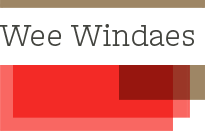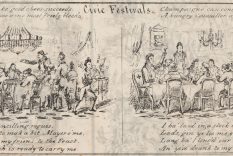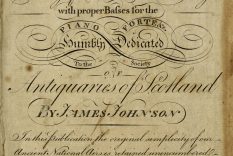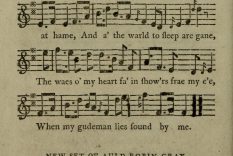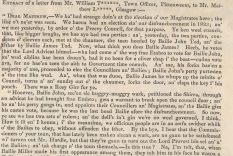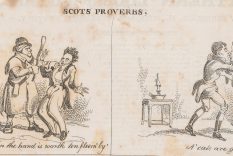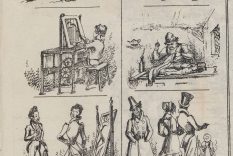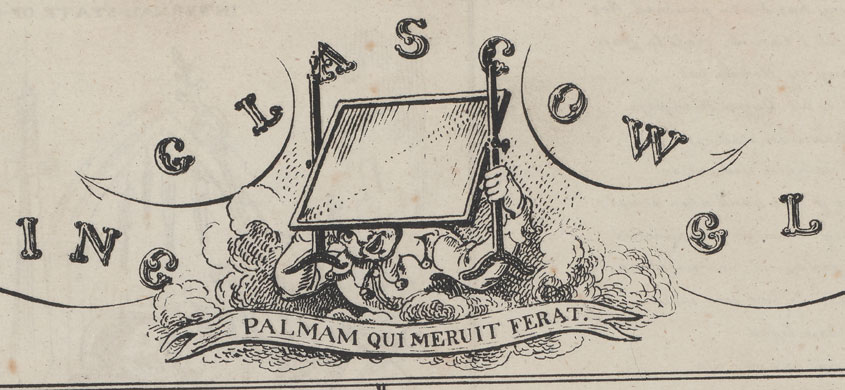
Hit’s no aften there a birth o a brent new medium houanever in Juin o 1825, in Glesga, whit’s noo kent as the warld’s first comic wis prentit unner the title ‘Glasgow Looking Glass’.
Hit wis prentit uisin the new technology o stane lithography at John Watson’s lithographic press on George Street. Ower the 19 issues pitten oot athin the year, tae Juin 1826, aw the pairts we noo expect o a comic emerge.
The paper is cheifly in staunnart English, houaniver hit’s gless focusses on the civil life o Glesga an Scotland an Scots language is throu hit fae first tae last lik a stalk o rock.
Lear mair aboot Glasgow Looking Glass
Stane lithography wis inventit at the hinner en o 1800. Bi the early 1820s hit wis a guid tredd at the cuttin edge o modren communications. The process alloos fir scrievin direct on tae a stane suface wi a pincil made o ile or creash raither nor engravin on tae a plate o metal or a wuid-block. The stane is then treatit sae ainly the creashy line hauds ink. Perfeck fir drawin comics.
Ae Thomas Hopkirk, a Glesga investor, ained ane o Glesga’s first lithographic presses an bi 1825 ae John Watson wis prentin. Watson’s is the ainly nemm on ‘Glasgow Looking Glass’. The ainly airtist we ken the nemm o thit wirkt on the cairtoon periodical wis William Heath. In Glesga fae Lunnon tae paint twa three panoramas Heath taen tae cairicaturin whit he seen whan oot an aboot in Glesga.
Heath is taen, bi diffrin accoonts, fir bein the lane airtist an inventor o the ‘Glasgow Looking Glass’ throu tae bein ane o a haunfae o airtists an ane thit cam on efter hit haed stertit an left afore hit wis duin. He certainly wis a strang haun throu the run o issues.
The periodical hitsel is three pages o maistly cairtoons, thir bein single images wi a wee drappie text. Growin in popularity bi issue sax hit’s gettin selt Scotland- wide, sae hit’s nemm is chyngit tae ‘Northern Looking Glass’, bein at the time Scotland wis stylin hitsel as ‘North Britain’. At this pynt there a fowert page o pure text giein the news needit tae follae whit’s gaun on in the cairtoons. Hit’s this middle period o the publication hit’s at hits maist airtistic an inventive. Scots noo comes tae the fore.
Issue seeventeen is the last wi John Watson. Hit is then relaunched fir twa mair issues bi Richard Griffin & Co. Aw the pairts thit mak the Looking Glass the warld’s first comic are no there in this saicont series, tho they micht hae reemerged haed there been a third issue.
Heath wis, either aroon this tim or no lang efter, obligatit tae lea Glesga acause o moontin debts. He taen back tae Lunnon whaur he wirkt as a chairecaturist an pit forrit his idea fir a periodical consistin o cairtoons an strips. Eventually, in 1830, he stertit this periodical nemmed ‘Mclean’s Monthly sheet of Caricatures or The Looking Glass!’
The first comic book
Whit claim dis ‘Glasgow Looking Glass’ hae tae be taen as the first comic?
The twa candidates thit cam oot afore ‘Glasgow Looking Glass’ are ‘The Comick Magazine’ (1796) an ‘The Caricature Magazine’ (1808). The baith o thir reprentit ‘picture stories’ fae William Hogarth an Thomas Rowlandson respectivly, houanever the magazines theirsels wisna dedicatit tae cairtoons, bein maistly made up o text an nary a image. The ‘Glasgow Looking Glass’ is entirely haun drawn.
Ither features o comics an cairtoonin come oot throu the run. In the first issue we’r met wi juist cairtoons, single images wi or athoot text. On the first page o issue twa we get the stert o three series o cairtoons, ane o them consistin o twa ‘scenes’, whit we’d ken the day as panels. The ither twa hae the common comic feature o ‘to be continued…’ lettin us ken thit there a serialised storie fir tae be haed. On the third page we get the first o a common device uisit throu the hale run, twa pictures aside ane anither thit’s relatit settin ane aff agin the ither. This cairtoon is cryit ‘Wants’ whaur ae fulla is ootin the dingin rain an anither is hingin oot a windae o a hoose thit’s on fire.
Fae issue three we’v got a cairicature o the publisher, John Watson, reponin tae the letters o the reader. This is a feature thit persists throu the run wi hissel on the letterheid on the Hogmanay issue.
Bi issue fower we hae the first fu comic strip: ‘The History of a coat’. This echt panel follaes a sheep gettin sheart, throu loom an tailor on tae the back o a new ainer. This, no lik the contrastive twa panel cairtoons, gies the passage o tim atween panels an haes chairecters thit ye see again ower the panels. This ens wi a ‘to be continued… an the hale story arc o the coatie is gien throu bein saicont, third haun an mair, richt doon tae a wean feedin the wabbit auld bit o stuff tae the pigs.
In issue nine we stert seein the first speech bubbles an in issue ten we see a mair creative tak on showin the panels in ‘The Life of an Actress’. Bi issue 14 we hae a full three page wi seeven panels in sequence gaun throu o the events an tradeetions o a Glesga New Year.
Efter the ‘Northern Looking Glass’ is stertit up bi new prenter Richard Griffin & co. in the new form aa thir features is awa. It is noo a collection o single panel cairtoons. Hit’s ainly in the saicont last panel o the last edition we hae a glisk o the auld Looking Glass wi a panel merkit ‘No. 1’ an containin ae final cairicature o John Watson.
Scots language in the Glasgow Looking Glass
Stertin aff, the ‘Glasgow Looking Glass’ is in staunnart English, maistly wi the exception o proper noons. Trongate, the street whaur the tron wis; Correspondents ‘Tron Steeple’ an ‘Auld Reekie’; Uisages lik ‘dundstead’ in place o ‘dungheap’. In the first issue there the wird ‘numpskull’, mibbie a granfaither o the wird ‘numpty’.
Houaniver, as the paper grows alang wi hits readership, Scots comes tae the fore. In issue sax, whaur the nemm chynges tae ‘Northern Looking Glass’ we get wir first full Scots language cairtoons. Anent the Edinburgh Toon Cooncil election o a new provost, set atweesh Mr William Trotter, thit won oot, an ae Mr Allan. The first cairtoon is cried ‘The twa Provosts’. The saicont cairtoon, ‘Civic Festivals’, gies baith candidates in their ain panels haudin a denner fir a wheen o cooncilors wi the tane sayin:
‘Oh! ye wee councilling rogues,
Ye promised to mak a bit Mayor o’ me
I’ve speer’d a’ my friens to the Feast,
And my coach is ready to carry me’.
an the tither:
‘I ha’ laid in a stock o ‘ Champaigne,
Lads, gin ye loo me, elec me now;
Lang ha’ I long’d owr auld Reekie to reign,
An’ ye’ve drunk to my health as Provost I trou.’
In this edeetion an aa there talk on Glesga ‘bailies’ an the new series Modern Medical Education sterts in the ‘Kirk yard’.
Neist issue there a cairtoon wi a ‘noddy’ horse an carridge in a affae stramash quotin the popular Burns sang ‘an we’re a’ noddin, nid, nid noddin’. In the echt issue we hae phrases sic as:
- ‘the Mad Brig’
- ‘That’s the scamp fallow that gart my teeth clatter! He’s jist a whang o’ the Devil’s hide’
- ‘Get mae to look at him than gie him ought’
throu the new typeset last page.
In issue nine we hae a extract fae a letter fae Pittenweem tae Glesga:
‘Pittenween Election
Extract of a letter from Mr William T******, Town Officer, Pittenweem, to Mr. Mattew L*****, Glasgow: –
Dear Matthew, – We ha’ had strange doin’s at the election o’ our Magistrates here; the like o’t ne’er was seen. We haena had an election sin’ our disfrancheesment in 1823; an’ we met yesterday, by order o’ the Preevy Cuncil, for that purpose. Ye ken weel eneuch, that, like bigger brughs, we hae aye had twa perties: an’, yesterday, the twa perties, consisten o’ eleeven each, met at the chaumer, the taen heeded by Bailie John Tod, an’ the tither by Bailie James Tod. Now, what think you does Bailie James? Hech, he votes that the Lord Advicat himsel – wha had come a’ the way frae Embro to vote for Bailie John, an’ wud aiblins hae been droun’t, had it no been for a cliver chap i’ the boat – cudna vote ava, for no hae’n taen the aith to Government time eneuch. An’ sae, his focks hae’en a majority o’ ane, proceeded to elec the Councillers an’ Bailies; Bailie John’s perty purtesten a’ the time like wud. An’, whan that was dune, Bailie James he whups up the minits o’ Council, turns a’ an’ sundry out o’ the chaumer, locks the door, an’ claps the key i’ his pouch. There was a Rosy Girr for ye.
Hooever, Bailie John, see’en sic huggry-muggry wark, petitioned the Shirra, through an advicat he had brought frae Embro; gets a warrant to break open the council door; an’ he an’ his perty gangs in, and appoints their Councillers an’ Magistrates, an’ the Bailie gies his casten vote, because he was the last head Bailie afore the disfrancheesment. So now, ye see we hae twa sets o’ rulers; an’ the deil’s in’t gin we’re no weel governed, I think. How it ill en’ I kenna; i’ the meantime, we officious people are in an awfu swither whilk o’ the Balies to obey, without offenden the ither. By the bye, I hear that the Commissioners o’ your toun, that hae lately been maken siccan a wark, are no gaunto be satisfeed wi’ turnen out Mr. Hardie, but that they’re gaun to turn out the Lord Provost his-sel an’ a’ the Bailies; an’ tak charge ‘ the toun themsels. – Is this true? Na, I’m telt, that, whan Bailie Miller made his first appearance amang them, they telt him to his face he wasna a Bailie ava, for a’ his cockit hat an’ his chain; an’ frichen’t him out o’ his wuts, about sponsibility, an’ pay lists, an’ sic like. I think the warl’s gaen gyte!’
This seige gets hits ain twa panel strip i the issue.
Issue 10 haes a Scots sang cryit ‘New Music’. The sang is a satyre o William, Duke of Clarence and St Andrews fae the pynt o view o his wife, Princess Adelaide of Saxe-Meiningen. William, the third son o George III, haed bade wi a Irish Actress, Mrs Jordan, haein ten illegitimate bairns oot o mairridge wi her. He’d nae siller left bi the 1810s an wis efter a wife wi siller hersel. He fun that in Princess Adelaide. Efter peyin aff his debts the succession tae the croon became a issue. His auldest brither, George IV, haed nae bairn an heir. His saicont auldest haed nane tae, sae hit luikit lik the croon wid faa tae William, whilk hit did in 1830.
‘New Music’
‘Young Willie loed my pounds, and asked me for his bride,
For saving his Crown, he had naething else beside,
To mak my pounds his ain, his Dutchess I’m to be,
But the Crown as weel’s the pounds are baith for me’.
The tune an lyric o this ‘New Music’ wis taen fae a popular sang o the tim, ‘Auld Robin Gray’. This sang wis collectit in the ‘Scots Musical Museum’ imprentit in 1790 an in the ‘Edinburgh Musical Miscellany’ o 1792. Ae Reverand William Reeves, an English vicar, laid claim tae authorin the sang an gied hit a new tune. Sae in 1825, the year o the ‘Looking Glass” appearance, at her request, Walter Scott finally revealt Lady Anne Lindsay as the genuine author.
‘Auld Robin Gray’
‘Young Jamie lood me well and he sought me for his bride,
But saving a crown he had nothing beside,
To make that crown a pound my Jamie gade to sea,
And the crown and the pound were baith for me’.
Ower the neist twa issues there a we tait Scots, ae cairtoon on ‘awfu weather’ an the special on New Year haes Licht learies an noddy drivers, an a mention o (black) currant buns, het pints an first fittin, tradeetional pairts o a guid hogmanay.
The last cairtoon in the Watson run o the ‘Looking Glass’ tae hae Scots is anent the dingin doon o Carlton hoose bi King George IV. Hit wis his residence whan he wis Prince Regent, syne he became king he raithert Buckingham Hoose. Carlton hoose wis taen doon an fine terraced hooses wis buggit in their steid. The profits fae thir hooses went tae the biggin o Buckingham Palace.
The cairtoon is cried ‘Sign of Bad Times’ wi twa seatit fullas crackin aboot the hoose: ‘So they are going to pull down Carlton House. What can that be for?’ An the Scot: ‘Hout mon! they’re wanting stanes for the new hoose, and havena the siller to send to Scotland for ’em’.
In the ‘New Series’ there a haunfae o Scots wirds an phrases in the typeset pairt an an anooncement o a new corner fir poems in either Scots or Modren Herbrew. In the saicont an final issue we hae fower cairtoons in a section nemmit ‘Scots Proverbs’. Here we fin illustrations o ‘Ae bird in the hand is worth ten fleein’ by’, ‘A’ cats are grey i’ the dark’, ‘Far frae court far frae care’ an ‘Daughters & dead fish are nae Keeping ware.’
The saicont hinmaist poem o the hinmaist issue is cried ‘The Rule of Drink’. Giein thit Heath is telt tae hae haen tae flit awa fae Glesga fir drink an debt hit’s mibbie gey suitit tae en wi this.
‘The Rule of Drink’
‘Quo’ Neil, of drink, it is the rule,
Tae change the wise man tae the fool;
Now a’ Neil’s friends most gravely think,
Neil needna fear a drap o’ drink.
R.’
It isn’t often that a new medium is born. However, in June of 1825 in Glasgow, what is now recognised as the world’s first comic, was printed. It was titled ‘Glasgow Looking Glass’.
The new printing technology of stone lithography had come to Glasgow and ‘Looking Glass’ was printed by John Watson at his press on George Street. Within the pages of each of the 19 issues of the periodical, all published inside a year, every one of the features we would expect of a modern comic can be seen.
The periodical is mostly in standard English. However, as its topics concern civil life in Glasgow and Scotland, Scots language runs through it from the first to the final issue like a stick of rock.
Learn more about Glasgow Looking Glass
Stone lithography was invented in the last years of the 18th century. By the early 1820s it was becoming a functional trade at the cutting edge of modern communications. The printing process involves drawing indirectly on to a flat stone surface with an oil pencil as opposed to images being engraved on metal plates or carved into blocks of wood. The stone surface is then treated so only the greasy line takes ink, perfect for quickly drawing comics.
Thomas Hopkirk, a Glaswegian investor, owned one of the city’s first lithographic presses, and by 1825 a John Watson was printing. Watson is the only name on ‘Glasgow Looking Glass’ and the only artist we can identify is William Heath. Arriving in Glasgow from London in order to paint panoramas, Heath began caricaturing things he saw around Glasgow. He is credited with being the author of a number of different works. From being the sole artist and inventor of the ‘Glasgow Looking Glass’ to being one of a handful of artists who came on board after the print run had started and leaving before it ended. Whatever the case, he certainly had a strong hand through the central run of issues.
The periodical is three pages long consisting of mostly cartoons, these being single images usually with a small amount of text. Growing in popularity, by issue six its circulation is Scotland-wide. This resulted in a name change to ‘Northern Looking Glass’ which was at a time when Scotland was referring to itself as ‘North Britain’. Also at this time a fourth page is added. This was a typeset page of news to serve as explanatory text for the cartoons. It’s during this middle period that the publication is at its most artistic and inventive. It is also the period where Scots becomes a significant feature.
Issue 17 is the last which John Watson prints. ‘The Northern Looking Glass’ is then relaunched for two more issues by Richard Griffin & Co. All the features which made the ‘Looking Glass’ the world’s first comic are now absent from the second series, although they may have re-emerged had further issues been printed.
Heath was obliged to leave Glasgow due to mounting debt. He returned to London where he resumed work as a caricaturist, all the while putting forward an idea for a periodical consisting of cartoons and strips. Eventually, in 1830, he started on a periodical known as ‘Mclean’s Monthly sheet of Caricatures’, or ‘The Looking Glass’!
The first comic book
What claim does ‘Glasgow Looking Glass’ have to being the world’s first comic? Two candidates which precede ‘Glasgow Looking Glass’ are ‘The Comick Magazine’ (1796) and ‘The Caricature Magazine’ (1808). These were reprinted ‘picture stories’ by William Hogarth and Thomas Rowlandson respectively. These magazines were not dedicated to cartoons however, as they were mostly made up of text and very few images. ‘Glasgow Looking Glass’ was entirely hand drawn.
Other features of comics and cartooning emerge through the run. In the first issue there are only cartoons, single images with or without text. On the first page of issue two there is the start of three series of cartoons, one consisting of two ‘scenes’, what we today call ‘panels’. The other two end with the now familiar phrase ‘to be continued…’, letting us know the story will be serialised across other issues. On the third page there is a device common throughout the whole run, two juxtaposed images creating meaning through their contrast. This cartoon is called ‘Wants’ and begins by showing one man caught in the rain beside another whose house is on fire.
From issue three a caricature of the publisher, John Watson, responds to readers’ letters. This is a feature which persists throughout the run where he is even depicted in the letterhead of the New Year issue.
In the fourth issue there is the first full comic strip – ‘The History of a coat’. Eight panels follow the fleece of a sheep from being sheared via a loom and a tailor to the new owner of a coat. This, unlike the contrasting two panel cartoons shows the passage of time and the persistence of characters across panels. This ends with a ‘to be continued’ where in later issues we see the coat passing through a number of hands and eventually, being worn out, it’s fed to a pig.
In issue nine there are the first speech bubbles and in issue 10 there is creative presentation of multiple panels in ‘The Life of an Actress’. By issue 14 there is a full three-page, seven-panel sequence covering a Glasgow New Year.
In the ‘New Series’ of the ‘Northern Looking Glass’, started by new printer Richard Griffin & Co. all of these features are absent. ‘The Northern Looking Glass’ is now a collection of single panel cartoons. It is only in the penultimate panel of the last issue that we have a hint of the old ‘Looking Glass’, with a panel marked ‘No. 1’ which contains one final caricature of John Watson.
Scots language in the Glasgow Looking Glass
From its outset the ‘Glasgow Looking Glass’ is in standard English, with the exception of a few proper nouns. ‘Trongate’, the street where the communal scales stood, correspondents ‘Tron Steeple’ and ‘Auld Reekie’, usages like ‘dunstead’ in place of ‘dungheap’. In the first issue the word ‘Numpskull’ appears, this form perhaps an antecedent of the word ‘numpty’.
However, as the periodical develops, along with its readership, Scots becomes more prominent. In the sixth issue, where the name changes to ‘Northern Looking Glass’ there are first cartoons containing Scots language in full. The scene is about the Edinburgh town council election of a new provost, a race between a Mr William Trotter, the eventual winner, and a Mr Allan.
The first cartoon is called ‘The twa Provosts’. The second, ‘Civic Festivals’ shows both candidates, each in their own panel, holding a feast for a group of councillors with one saying:
‘Oh! ye wee council ling rogues,
Ye promised to mak a bit Mayor o’ me
I’ve speer’d a’ my friens to the Feast,
And my coach is ready to carry me.’
and the other councillor:
‘I ha’ laid in a stock o ‘ Champaigne,
Lads, gin ye loo me, elec me now;
Lang ha’ I long’d owr auld Reekie to reign,
An’ ye’ve drunk to my health as Provost I trou.’
Also in this issue there’s talk of Glasgow ‘bailies’ and the new cartoon series ‘Modern Medical Education’ begins in the ‘Kirk yard’.
In the following issue there is a cartoon with a ‘noddy’ horse and carriage in distress. The caption quotes the popular Burns song ‘an we’re a’ noddin, nid, nid noddin.’ In the eighth issue we find phrases in the typeset page such as: ‘the Mad Brig’, ‘That’s the scamp fallow that gart my teeth clatter! He’s jist a whang o’ the Devil’s hide’, and ‘get mae to look at him than gie him ought.’
In issue nine there is an extract from a letter from Pittenweem to Glasgow:
‘Pittenween Election.
Extract of a letter from Mr William T******, Town Officer, Pittenweem, to Mr. Mattew L*****, Glasgow:-
‘Dear Matthew, – We ha’ had strange doin’s at the election o’ our Magistrates here; the like o’t ne’er was seen. We haena had an election sin’ our disfrancheesment in 1823; an’ we met yesterday, by order o’ the Preevy Cuncil, for that purpose. Ye ken weel eneuch, that, like bigger brughs, we hae aye had twa perties: an’, yesterday, the twa perties, consisten o’ eleeven each, met at the chaumer, the taen heeded by Bailie John Tod, an’ the tither by Bailie James Tod. Now, what think you does Bailie James? Hech, he votes that the Lord Advicat himsel – wha had come a’ the way frae Embro to vote for Bailie John, an’ wud aiblins hae been droun’t, had it no been for a cliver chap i’ the boat – cudna vote ava, for no hae’n taen the aith to Government time eneuch. An’ sae, his focks hae’en a majority o’ ane, proceeded to elec the Councillers an’ Bailies; Bailie John’s perty purtesten a’ the time like wud. An’, whan that was dune, Bailie James he whups up the minits o’ Council, turns a’ an’ sundry out o’ the chaumer, locks the door, an’ claps the key i’ his pouch. There was a Rosy Girr for ye.
Hooever, Bailie John, see’en sic huggry-muggry wark, petitioned the Shirra, through an advicat he had brought frae Embro; gets a warrant to break open the council door; an’ he an’ his perty gangs in, and appoints their Councillers an’ Magistrates, an’ the Bailie gies his casten vote, because he was the last head Bailie afore the disfrancheesment. So now, ye see we hae twa sets o’ rulers; an’ the deil’s in’t gin we’re no weel governed, I think. How it ill en’ I kenna; i’ the meantime, we officious people are in an awfu swither whilk o’ the Balies to obey, without offenden the ither. By the bye, I hear that the Commissioners o’ your toun, that hae lately been maken siccan a wark, are no gaunto be satisfeed wi’ turnen out Mr. Hardie, but that they’re gaun to turn out the Lord Provost his-sel an’ a’ the Bailies; an’ tak charge ‘ the toun themsels. – Is this true? Na, I’m telt, that, whan Bailie Miller made his first appearance amang them, they telt him to his face he wasna a Bailie ava, for a’ his cockit hat an’ his chain; an’ frichen’t him out o’ his wuts, about sponsibility, an’ pay lists, an’ sic like. I think the warl’s gaen gyte!’
This siege receives its own two panel strip in the issue.
Issue 10 has a song in Scots entitled ‘New Music’. This song lampoons William, Duke of Clarence and St Andrews, from the point of view of his wife, Princess Adelaide of Saxe-Meiningen. William, the third son of George III, lived with an Irish actress, Mrs Jordan, and had 10 illegitimate children with her. By the 1810s he was heavily in debt and sought a wife who was independently wealthy. He eventually found that in Princess Adelaide. After she paid off his debts the succession to the crown of Great Britain became a pressing concern. William’s oldest brother, George IV, had no child and heir. His next oldest brother didn’t either so it looked like the crown would be inherited by William, which is what happened in 1830.
‘New Music’
‘Young Willie loed my pounds, and asked me for his bride,
For saving his Crown, he had naething else beside,
To mak my pounds his ain, his Duchess I’m to be,
But the Crown as weel’s the pounds are baith for me.’
The tune and lyric of this ‘new music’ was taken from a contemporary popular ballad, ‘Auld Robin Gray’. This song was collected in the ‘Scots Musical Museum’ published in 1790 and in the ‘Edinburgh Musical Miscellany’ of 1792. Reverend William Reeves, an English vicar, had claimed authorship of the song and even gave it a new tune. By 1825, the year of the ‘Looking Glass” first appearance, at her request, Walter Scott finally revealed Lady Anne Lindsay as the genuine author.
‘Auld Robin Gray’
‘Yong Jamie lood me well and he sought me for his bride,
But saving a crown he had nothing beside,
To make that crown a pound my Jamie gade to sea,
And the crown and the pound were baith for me’.
Over the next few issues there is a little more Scots, one cartoon on ‘Awfu weather’ and the special on New Year using a few culturally relevant terms.
The final cartoon in the Watson run of the ‘Looking Glass’ using Scots is about the demolition of Carlton house by king George IV and called ‘Sign of Bad Times’. This was his residence during his regency though after he became king he preferred Buckingham House. Carlton House was demolished and fine town houses were built in its place. The profits on the sale of these houses were used to finance the building of Buckingham Palace.
The cartoon depicts two older gentlemen discussing Carlton House: ‘So they are going to pull down Carlton House. What can that be for?’ And the Scot: ‘Hout mon! they’re wanting stanes for the new hoose, and havena the siller to send to Scotland for ’em’.
In the ‘New Series’ there are a few Scots words and phrases in the typeset page and an announcement that there will be a new corner, called ‘The Jew’s Harp’ where poems in either Scots or Modern Hebrew would be printed. In the second and final issue there are four cartoons in a section called ‘Scots Proverbs’. Here there are illustrations of ‘Ae bird in the hand is worth ten fleein’ by’, ‘A’ cats are grey i’ the dark’, ‘Far frae court far frae care’ an ‘Daughters & dead fish are nae Keeping ware’.
The penultimate poem of the last issue is a Scots poem, ‘The Rule of Drink’. Given that Heath is said to have left Glasgow due to debts in no small part accumulated through drink, this is, perhaps, an appropriate way to finish.
‘The Rule of Drink’
Quo’ Neil, of drink, it is the rule,
Tae change the wise man tae the fool;
Now a’ Neil’s friends most gravely think,
Neil needna fear a drap o’ drink.
- Author:
- Various
- Publication Date:
- 1825
- Imprentit:
Glasgow
Civic Festivals
‘Oh! ye wee councilling rogues,
Ye promised to mak a bit Mayor o’ me
I’ve speer’d a’ my friens to the Feast,
And my coach is ready to carry me’.‘I ha’ laid in a stock o ‘ Champaigne,
Lads, gin ye loo me, elec me now;
Lang ha’ I long’d owr auld Reekie to reign,
An’ ye’ve drunk to my health as Provost I trou.’
